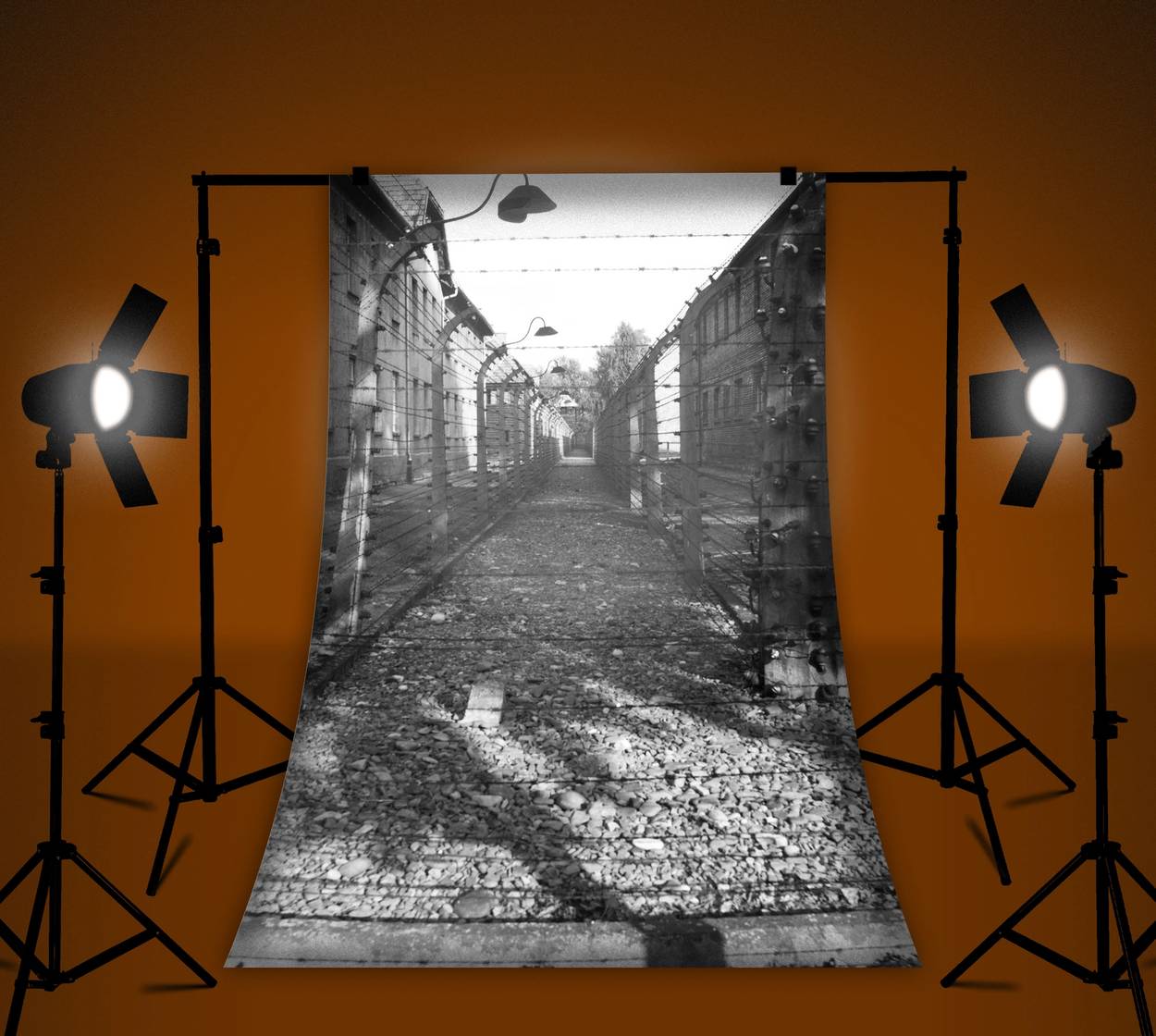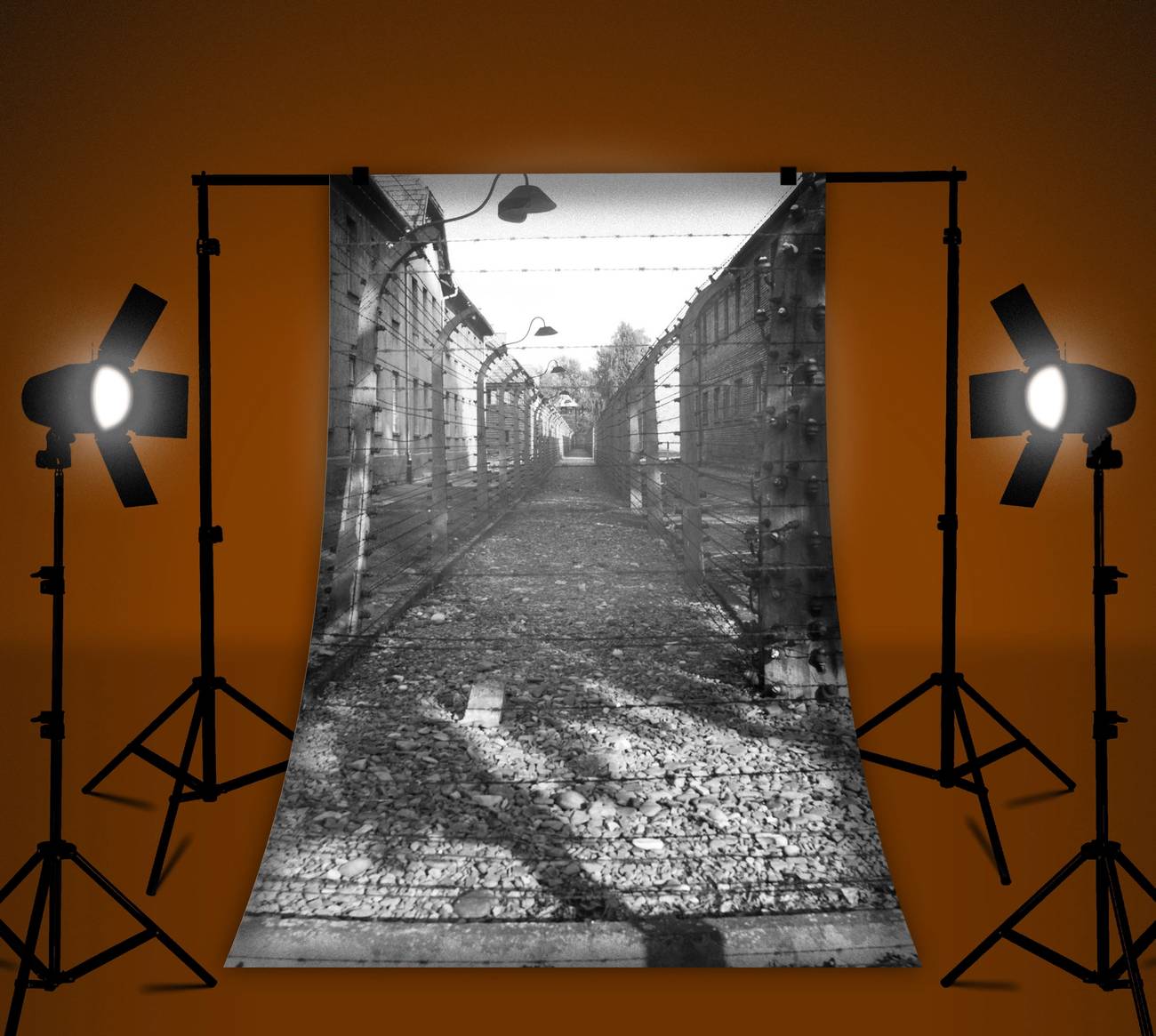Preparing for a World of Holocaust Deepfakes
Combating the mother lode of misinformation—Holocaust denial—reveals that the problem is not simply detecting lies, but figuring out what’s true




The problem with the most pernicious lies is that they are often based on elements of truth.
In a now-famous image known as the Ivanhorod Einsatzgruppen photograph, six huddling Jews were captured on film while being menaced by a rifle-wielding German soldier in Ukraine. Taken in 1942 by an unknown individual, the image was intercepted by the Polish resistance and eventually made its way into public view after the war, providing a chilling personal window into the horrors of the Holocaust.
Years later, however, the picture was enlisted in the service of Holocaust denial. In 1962, a far-right West German newspaper claimed that forensic experts had determined the Ivangorod Einsatzgruppen photograph was fake, and that it had been staged by Polish communists to wrongfully depict German war crimes. The result was a back-and-forth, he said, she said of media forensics until the fraudulent claim was eventually debunked in 1965.

Crucially, the West German newspaper did not need to edit or alter the photograph itself to cast doubt on its authenticity. Instead, the propagandists used the true, real picture, and merely declared that it had been faked.
This is far from the only time that accurate Holocaust imagery has been deployed to undermine the historical facts of the Holocaust. In 2018, a viral meme on Facebook purported to feature the billionaire and liberal financier George Soros dressed as a Nazi.

The meme actually featured a real photograph—but it was not George Soros. It was a Nazi guard named Oskar Gröning.
The viral Soros meme is relatively new, but the problem it illustrates is old. Holocaust denial has long relied on real images—and different tactics for image manipulation, editing, and recontextualization—as well as simple claims of forgery or inaccuracy, since well before the dawn of the social media era. Paradoxically, many of the same images that have become most important for verifying the Holocaust have also been used by Holocaust deniers to advance conspiracy theories.
While this might seem like an esoteric point, mostly of interest to scholars of Holocaust denial, understanding it could be essential for future attempts to combat online misinformation. That’s because the danger we face today comes less from entirely fabricated media than from carefully massaged authentic media. The challenge is not so much the spread of “misinformation” as figuring out what constitutes “misinformation” in the first place.
Any adequate response to this challenge will need to reckon not only with outright lies, but the manipulation of truth.
Over the past several years, deepfakes have captured the attention of technology companies and organizations concerned with the preservation of historical truth. A portmanteau of “deep learning”—a subset of machine learning in artificial intelligence—and “fake” video representations of real people and situations, deepfakes are AI-generated media that have prompted many to warn of an era in which “seeing is no longer believing,” or of an upcoming “information apocalypse.” The thinking goes: Won’t all of the unsophisticated meme-makers who now create misleading George Soros graphics soon use artificial intelligence tools to make increasingly photorealistic, and cognitively sticky, fabricated media?
As with all dual-use technologies, there is some truth to the concerns about content that has been generated or modified via automation, often referred to as “synthetic media.” After all, it’s not hard to envision a deepfake Hitler saying that he loves Jewish people and would never harm them. And it’s true that deepfakes can and will be used to exploit, manipulate, harass, persuade, and misinform. But they can also be used to speak truth to power, satirize, poke fun, protect one’s privacy, and even preserve historical memory.
More worrisome than any particular fraudulent video is the damage that such media can inflict on the public’s trust. Legal scholars Bobby Chesney and Danielle Citron call this the “liar’s dividend”: The more people understand that images and videos can be synthesized with AI, the more distrusting of all real and authentic content they will be. There might not need to be a deepfake of Hitler saying that he loves the Jews to fuel Holocaust denial. One need only suggest that the real video evidence has been synthesized with AI, and many people will likely call into question all photographic proof of the Holocaust—a fog of doubt that could similarly descend on all videos of police shootings and terrorist attacks. As Holocaust deniers have long understood, the truth can be manipulated without the need for manufacturing whole falsehoods.
To date, social media platforms have predominantly focused on how deepfakes threaten to impact our politics. When no malicious deepfake went viral before the 2020 U.S. election, these platforms breathed a collective sigh of relief. But they did see plenty of low-tech content that they defined as misleading or manipulated media. When these technology companies attempted to counter this phenomenon with new policies on synthetic media, it often did more to expose the limits of their judgment than the effectiveness of their oversight.
While it is commendable that outlets like Twitter, Facebook, TikTok, and YouTube have started to take these problems seriously, they are clearly unable to operationalize and enforce nuanced, context-specific policies in this area. More fundamentally, these platforms do not have coherent definitions for the content they want to regulate. Does a Chinese official using staged photos of happy-looking hostages to obfuscate the regime’s repression of its Uyghur population count as causing real-world harm? (Apparently not.) What about content that causes emotional distress? Even operating with the best of intentions, many platforms lack the historical, cultural, and contextual awareness that might be required to evaluate content as “misleading” or “hateful.”
To understand why, let’s turn to Nazi imagery. Many consider this to be the easiest category to moderate, but it isn’t. Is a swastika a hate symbol? Yes, if it’s spray-painted on a Jewish synagogue. No, if it’s found in a Hindu temple, or in any of the many other Eastern cultures where the sign held deep religious significance long before the Nazis appropriated it. These contextual differences make it extremely difficult for social media platforms to meaningfully enforce their content moderation policies and build systems to scale their enforcement. Algorithms, and even people, have a hard time deciding what content violates which rules.
Consider how these platforms would treat a 1944 photograph from Czechoslovakia that is now understood to misleadingly depict the Theresienstadt ghetto.

In this photo, the children pictured look nourished, thriving, and joyous. But it was later proven that the ghetto was beautified and stage-managed prior to an inspection by the International Red Cross. In other words, this is an authentic photo, where there has been no editing or cropping or photographic misrepresentation of what those children in that ghetto looked like at the moment that picture was taken—but it is not an accurate representation of reality. Would a Facebook algorithm or a random overseas content moderator know enough to properly label this image or respond to its misuse?
Similarly, how would they deal with other edge-case examples, like this image housed at Yad Vashem and posted to Twitter by Tablet’s own Yair Rosenberg in 2018:
At first glance, the photo depicts the Soviet liberation of Auschwitz. But as Holocaust historians have shown, what actually happened was more sinister. As Rosenberg noted, “When the Soviets liberated Auschwitz, they forgot to bring a camera to document it. So they came back with one and had the starved Jewish inmates reenact the liberation for their propaganda.”
If this post is retweeted with the accurate caption, “This Holocaust image is staged,” would it be violating Twitter’s policies? In fact, it has been reshared in this way many times—by Holocaust deniers.
What these examples all demonstrate is that policies for synthetic and manipulated media—even in concert with policies on Holocaust denial content—are unlikely to identify many posts as violative without deep historical understanding of the images in question. If even an “easy” case like Holocaust denial is actually hard for the misinformation complex to adjudicate, it can’t be expected to tackle the hard cases.
So what can be done? Quite a lot, actually. We just have to take a different approach.
Much of the preparation for countering misinformation to date, like the 2019 Deepfake Detection Challenge spearheaded by Facebook, Microsoft, Amazon Web Services, and the Partnership on AI (where I lead the AI and Media Integrity Program), has fixated on the technical detection of deepfakes—in other words, figuring out how to prove that something is false, not that something is true. These and similar efforts have resulted in the identification of content categories that social media platforms feel they should reject, but not in the improvement of their actual judgment or ability to enforce such policies at scale. As we’ve seen, the expansion of content moderation by itself is not a recipe for good or consistent decision-making.
But if we learn from the insidious tactics of Holocaust denial, which rely on manipulating legitimate media as much as fabricating it, better solutions may become apparent. The trick may be to turn the entire misinformation paradigm on its head: Instead of trying to identify and eliminate what is false, give users the power to figure out what is true.
Rather than detecting falsehoods, platforms could focus on integrating nonfungible digital signals that enable users to verify that content is real, thereby increasing trust in legitimate, authentic, unedited media.
What would this look like in practice? As an example, let’s take the George-Soros-as-Oskar-Gröning meme. Such content depends on the viral logic of social media sharing, which makes it easy to lose track of the content’s origins—in this case, a photograph of a Waffen SS officer from the Museum Auschwitz-Birkenau, via the Associated Press. But imagine a world in which you could track the provenance of a visually manipulated artifact. Notably, such provenance markers would be hard to forge, as they are based on cryptographically unalterable data structures and digital signatures baked into the content.
In the case of the Soros meme, it would go something like this: A report surfaces on Oskar Gröning, including a photo of him that features an embedded digital signature, linking it to the original report. A YouTuber or Facebook user then copies the Gröning image into a video or meme, claiming it’s George Soros, but the digital signature remains with the image. At this point, regardless of how the photo has been manipulated, end users would be able to view the implanted reference to the photo’s origin—its digital signature—from the Museum Auschwitz-Birkenau, via the Associated Press.
The current detection models used by tech platforms are unlikely to pick up this kind of meme as having been manipulated. But with provenance data displayed alongside the image artifact, users could trace it back to Gröning themselves, thereby enabling them to debunk the meme on their own while also strengthening their understanding of the historical reality.
Crucially, this approach could completely invert the failed “misinformation” paradigm. Instead of focusing on figuring out what is false, it could help people figure out what is true. Rather than empowering unaccountable platforms to judge what content users see, it could empower users with the tools to make their own calls. Simply put, this approach relies on addition to the information ecosystem, rather than subtraction.
Beyond exposing low-tech manipulations of media like the Soros meme, provenance information might also be advantageous for dealing with the “liar’s dividend” challenge of an increasingly AI-edited visual reality. High-stakes visual evidence—from news events like elections to historical documentation of events like the Holocaust—could be authenticated and strengthened through broadly adopted provenance-based technologies. In fact, the University of Southern California’s Shoah Foundation has recently started collaborating with Stanford University’s Department of Electrical Engineering to cryptographically certify the video testimonies of Holocaust survivors.
If provenance information infrastructure could potentially be so useful, why haven’t you heard about it?
Simply put, while there has been cross-sector excitement around such technology, social media platforms have not been at the forefront. In February 2021, a coalition of top tech and media companies formed the Coalition for Content Provenance and Authenticity (C2PA). Founding members included Adobe, the BBC, Intel, Microsoft, and Truepic, a startup developing mechanisms to verify images from the point of capture. Just as those in the computer security field standardized our “hypertext transfer protocol secure,” better known as HTTPS, and its accompanying padlock iconography to signal and ensure secure communications, C2PA wants to integrate provenance signals into the distribution and consumption of online content.
But for the provenance signals and infrastructure to be useful, the standard must eventually be incorporated into the fabric of the web; at the moment, social media companies have been reluctant to get involved. There are compelling, if debatable, reasons why. As WITNESS—a video and human rights nonprofit involved in C2PA—has outlined, widespread provenance infrastructure technology could be used for surveillance and lead to severe privacy violations. A default system in which news outlets are pressured to authenticate their content might cripple new and smaller media outlets with less technical capacity. Journalists who rely on jailbroken devices while working in repressive countries might not be able to verify their content (authentication relies on verifying the phone capturing the image), which could inadvertently serve the cause of authoritarian regimes by discrediting unflattering content captured on their soil.
WITNESS’s involvement alone cannot resolve these questions, but it could help ensure that C2PA is actively weighing the trade-offs involved. Outside actors like social media platforms ought to bring their insights and concerns to the table, too.
Ultimately, establishing standards for contextual information is in the best interests of social media companies themselves. Until now, they have tried with little success to toe the line between arbitrating the truth and remaining neutral hosts. Provenance infrastructure could help ease this dilemma: If users have access to more universal information about where a piece of content comes from, they may be better able to resist misleading visual information, and won’t require the constant intervention of the hosting platform themselves.
Of course, this kind of intervention would place a lot of faith in users to take additional source information to heart, even as many of them are already profoundly skeptical of information appended to content. Nevertheless, platforms should not be paralyzed into passivity. By rigorously field-testing different approaches, social media platforms will be able to better determine what works and what doesn’t for any future provenance information infrastructure. More broadly, platforms should work alongside others in industry, civil society, and academia to embed additional signals of authenticity into the web.
Antisemitism is far from the world’s only bigotry, but it is one of the oldest, which is why studying it can yield insights about combatting many other forms of hate. Similarly, Holocaust denial is far from the only conspiracy theory to make use of manipulated media, but it is one of the most potent, which is why studying how it works can help us understand how to counter many other forms of misinformation.
By focusing on protecting and preserving the truth, not simply debunking what is false, we can collectively make it much harder for those who would deny historical events to thrive online, while empowering everyday individuals to better understand the world around them.
Claire Leibowicz leads the AI and Media Integrity Program at The Partnership on AI and is a 2021 Journalism Fellow at Tablet.